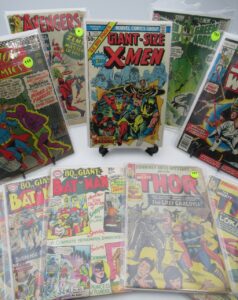We talk to people everyday about selling their collection (it’s what we do). Sometimes we hear, “I’ve already sold some of it, so here’s what’s left.” This makes us sad, not because we didn’t get to help with the whole deal, but because we know they’ve left money on the table! Why? Let us explain:
The Rising Tide Lifts All Boats
 Let’s say that you have a collection that’s worth a collective $10,000. The values there won’t be evenly distributed no matter what the collection is – some pieces will always be worth more than others. In this hypothetical collection, let’s say there are ten pieces that add up to a collective $3,000. The rest, boxes and boxes worth of stuff, make up the bulk of the value but in smaller individual sums. Ten bucks here, twenty-five there, etc.
Let’s say that you have a collection that’s worth a collective $10,000. The values there won’t be evenly distributed no matter what the collection is – some pieces will always be worth more than others. In this hypothetical collection, let’s say there are ten pieces that add up to a collective $3,000. The rest, boxes and boxes worth of stuff, make up the bulk of the value but in smaller individual sums. Ten bucks here, twenty-five there, etc.
The natural inclination of most do-it-yourself sellers is to carve out the big value chunk fast. In our professional opinion, that’s a mistake. It makes the amount of work needed to extract the full value so much more, sometimes to the point of not being worth the time. Many dealers won’t even touch a collection that’s been split up in this way for that very reason.
High-End Items Put Butts In Seats
Think of it in terms of doorbuster sales at Big Box stores. A store may only have ten of the most highly desired televisions, and those will sell out in a matter of seconds. But the deal will bring a hundred people looking to buy a TV through the door. Those other ninety people ? They’re primed to spend their money, maybe even a little more than they planned, on an alternative.They came in the door for a TV, and by gosh they’re leaving with a dang TV!

Pictured: Anchor lots for a bronze and silver age collection.
The same idea applies to the cream of a collection. Your high-grade Giant-Size X-Men #1 or sealed U.S.S. Flagg will only be realistically available to so many collectors, but it will get people’s attention. The more attention it gets, the more motivated buyers start laying money down on your other items. In an auction setting, this can push the value of more average items to the higher end of the expected range. Stuff that would sell for $20 on average might go for closer $40 when you introduce competitive buyers into the mix. Maybe the big-ticket items are already out of their price range, but folks walked through the (figurative or literal) door ready to spend some money. And spend money they will!
Don’t Let Anyone Cherry Pick Your Collection
Not even yourself! Selling your top-shelf stuff brings in some quick cash, but it leaves you holding everything else. At best, it will create a long, slow slog to extract the value. At worst, it will render the balance of the collection undesirable.
If you sell items yourself, you’re always getting the biggest chunk of the pie. That’s undeniable. But the benefit of consigning through or selling to a dealer like Back to the Past is that you will get the value for everything. An outfit like ours operates on a sliding scale, so you’ll still be getting the biggest chunk of those highly valuable items while the split on the smaller stuff will be a bit closer to even. But, and we cannot stress this enough, you will be monetizing the whole collection and converting it to a check in your hand quickly! In a consignment situation, your ten pieces worth $3k will anchor an auction session. They will support and raise up the less valuable items, and that’s the philosophy we use in building our auctions.
If you want us to do that something right for you, get in touch right away! We’re constantly booking new collections, so the sooner you give us a call, the sooner we can get your items sold. And if you want to ask us a question about this or any other blog topic, we’re always reachable in the comments or in our mentions @b2pcollect.








